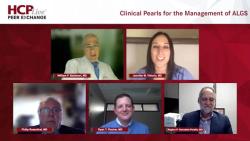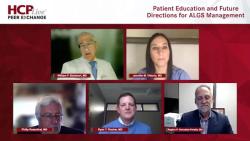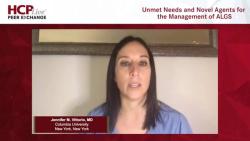Updates in the Management of Alagille Syndrome - Episode 9
Individualizing Treatment Approaches for ALGS Management
Drs Ryan T. Fischer and Regino Gonzalez-Peralta highlight the importance of tailoring treatment to a patient’s symptoms and define treatment success for Alagille syndrome.
William F. Balistreri, MD: Ryan, we talked about the issues in tailoring treatment, but I’ve been impressed by the parents’ groups networking and the alliances that have been formed. Many times, the parents come in and say, “I heard about this on the Alagille Syndrome Alliance. I heard about this, and I went to a meeting.” That can be very helpful in individualizing therapy. Tell us a little about your perspective as you tailor your treatment to the patient.
Ryan T. Fischer, MD: On those lines, I tend to walk into that one because I often recommend that our parents get online and Google, and do what you need to do. That creates more work for the physician, especially when there’s bad information that you have to address or talk someone back from the ledge on. But at the same time, those parents’ groups can be wonderful. Not simply for the treatment options that may or may not be discussed on there, but simply for the support that they get.
That ties into what we need to offer for these kids long term and how we need to think. Because we’re the primary managers of Alagille syndrome for these patients, we want to focus on those quality-of-life issues that may be coming up. You can put those blinders on and be like, “I’ve got this liver. I have to take care of it. I have to do what’s right.” But we’ll see these kids come in at various time points with multiple other things that we need to be aware of, like a cross country runner who has a lot of foot pain. Maybe there’s something going on that isn’t related to running a little too far. Maybe it’s truly a fracture or malformation in the bones of the foot and we need to make sure that we get them to the right people sooner rather than later to help assess that. Those things can be important.
As we mentioned at the outset, this disease is fascinating. It makes you go back to your resources over and over again because you learn something new or see something different that you didn’t expect from this patient coming into your office. Then you find out that there’s a way that we can put the strings together between these 2 points that says, “This makes sense. This is something that can happen for these patients, and we need to be ready for that.”
I still want to learn more about how we predict and best screen for the possibility of stroke or cerebral vascular anomalies in these children. Do we wait until they can hold still for an MRI? Or do we need to do something sooner? Do we need to do better with managing cholesterol in these children? A lot of them are going to have hypercholesterolemia associated with cholestasis and the disease itself. I’ve seen statins get mentioned as being used for children. I haven’t used them personally, hoping to do other things to limit cholestasis and help them out. But beyond the itching, which we’re going to talk about later, there are all these little other areas that come up, notwithstanding the good cardiac care and renal care that they’re going to need.
William F. Balistreri, MD: Thank you, Ryan. That clearly is a perspective. You reminded me of a statement I make to our fellows all the time: If you’ve seen 1 patient with Alagille syndrome, you’ve seen 1 patient with Alagille syndrome.” Because the next one is going to be very different. We talked about all the other common [issues], but we didn’t mention the autoimmunities, which are becoming more prevalent. We’ve certainly seen patients with Alagille with juvenile arthropathies and other autoimmunities. We need to also keep those in mind.
One last comment about the fractures. Reggie mentioned a 4-year-old coming into the emergency department with neurological symptoms. Yes, they could have a stroke, but I’d almost guarantee that everyone on this panel has had patients who had a minor injury bumping into the coffee table that was dismissed, and it turned out to be a pathologic fracture. That education component is key. Reggie, before we get into specific treatments, do you have any comments about any issues that we didn’t talk about in terms of treatment success, patient-related factors, or things that we need to be aware of and have our families and trainees aware of?
Regino P. Gonzalez-Peralta, MD: It was all pretty well covered, particularly with Ryan’s comprehensive assessment. I’d throw in that it’s happened more than once where you talk about fractures being missed after perceived minor trauma, for example, but the other way is also important. I’ve had families become [engulfed] in the division of family and children’s services for the other way around, where it’s a minor trauma and there’s a fracture, and they say, “This must be neglect or abuse,” and a molehill becomes a mountain. These families get put through the wringer, even as you’re saying, “This person has a reason and a risk for having a fracture.” It takes a while before that translates to, “It’s OK. It wasn’t child abuse.” That also needs to be thrown in the mix.
William F. Balistreri, MD: I see our panel all shaking their heads. We’ve all had patients exactly like that. Not just with Alagille but with PFIC [progressive familial intrahepatic cholestasis] and so on.
Regino P. Gonzalez-Peralta, MD: Correct.
William F. Balistreri, MD: Thank you, Reggie.
TRANSCRIPT EDITED FOR CLARITY



